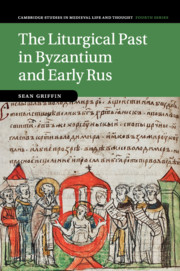Book contents
- The Liturgical Past in Byzantium and Early Rus
- Cambridge Studies in Medieval Life and Thought Fourth Series
- The Liturgical Past in Byzantium and Early Rus
- Copyright page
- Contents
- Acknowledgements
- Abbreviations
- Introduction
- Chapter 1 Liturgy and History in Early Rus
- Chapter 2 The Rus Primary Chronicle
- Chapter 3 Vespers at the Kiev Monastery of the Caves
- Chapter 4 The Dayspring Before the Sun:
- Chapter 5 A New Constantine in the North:
- Chapter 6 A RATIONAL SACRIFICE:
- Conclusion:
- Bibliography
- Index
Chapter 5 - A New Constantine in the North:
Prince Vladimir and the Baptism of Rus
Published online by Cambridge University Press: 09 August 2019
- The Liturgical Past in Byzantium and Early Rus
- Cambridge Studies in Medieval Life and Thought Fourth Series
- The Liturgical Past in Byzantium and Early Rus
- Copyright page
- Contents
- Acknowledgements
- Abbreviations
- Introduction
- Chapter 1 Liturgy and History in Early Rus
- Chapter 2 The Rus Primary Chronicle
- Chapter 3 Vespers at the Kiev Monastery of the Caves
- Chapter 4 The Dayspring Before the Sun:
- Chapter 5 A New Constantine in the North:
- Chapter 6 A RATIONAL SACRIFICE:
- Conclusion:
- Bibliography
- Index
Summary
Aleksei Shakhmatov proved over a century ago that the Rus Primary Chronicle combines two separate traditions about Prince Vladimir’s conversion: one about a Greek philosopher who travels to Kiev and another about the prince’s baptism following the siege of Cherson. The problem that Shakhmatov never treated, however, was why these two passages were redacted together in the first place. Chapter 5 examines this problem and argues that the redactions were made for liturgical reasons so that the chronicle would show Prince Vladimir establishing Christianity in Kiev much like the Byzantine rite shows ‘the apostle Constantine’ establishing it in the Roman Empire. The prince does precisely those things that the sainted emperor does in the hymnography: he converts because of a miracle and conquers his enemies with the ‘image of the Cross’. A detailed parsing of the liturgical elements reveals, moreover, that Vladimir imitates the deeds of Constantine in a rather unexpected way: he performs the liturgical roles prescribed for a bishop during the celebration of the divine liturgy. This discovery allows for the provocative new hypothesis that the Rus Primary Chronicle—when understood in its native liturgical context—actually depicts Prince Vladimir as the first bishop of Rus.
Keywords
- Type
- Chapter
- Information
- The Liturgical Past in Byzantium and Early Rus , pp. 134 - 187Publisher: Cambridge University PressPrint publication year: 2019

